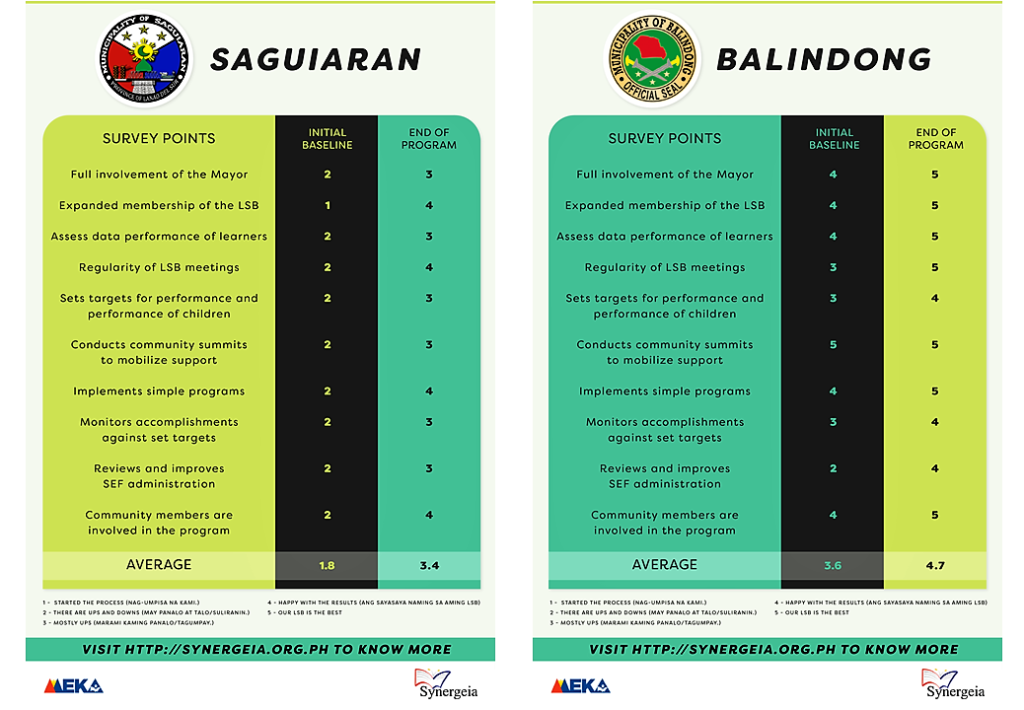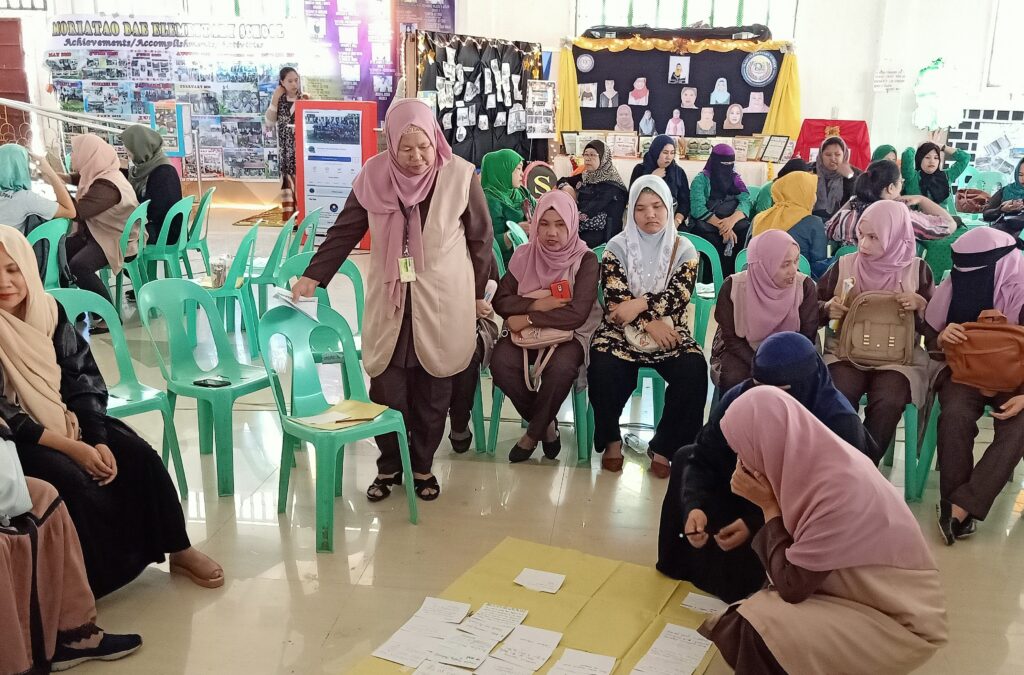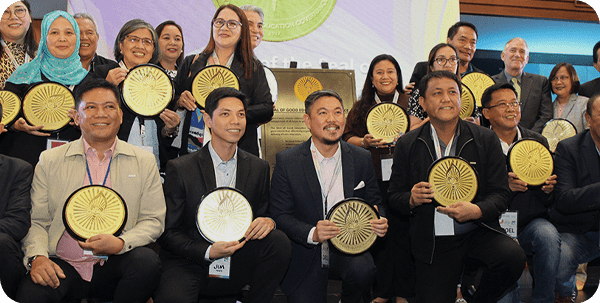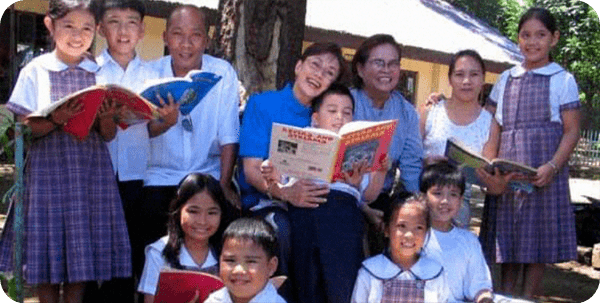
Ma’am Paypa Serad has been a member of the Local School Board of the Municipality of Balindong since 2015. Before becoming a member of the LSB, she was the principal in one of the secondary schools in the Municipality. As far as she can remember, before the partnership between the LGU and Synergeia Foundation, the LSB focused on three things: 1) The funding of sports events, 2) The naming of schools, and 3) the Designation and approval of District Supervisors.
When the partnership began, however, things began to change. The most evident change came in the active involvement of the Local Chief Executive in programs directly affecting the learning performance of the children. In addition, the LSB began discussing and analyzing education data, such as the enrollment rates, the drop-out rates, NAT test results, and School Reading Results meetings. Education programs began to take shape based on data. Moreover, teacher training and parent training gained greater importance.
The membership of the Local School Board also expanded to include representatives from the religious sector, business leaders, barangay officials, parent-leaders, youth leaders and representatives from the women-sector. With the expansion of the membership, ideas to improve the quality of education in the Municipality got better. The Local Government became conscious that the whole community ought to be involved. In Balindong, for instance, the membership grew from 8 to 15 members.
Hence, with the local school board taking a more active role in shaping the education agenda of the Municipality, the other members of the local community also began to be actively involved. The organization of the School Governing Councils began to take shape. To date, the Municipality of Balindong can proudly say that almost 95% of the school governing councils have their proper sets of officers and by-laws.
Even in the field of finance, the Synergeia-LGU partnership produced positive results. Ms. Serad shared that in 2016, the Special Education Fund of the Municipality averaged at Php 30,000. Today, the SEF has reached an average of Php 50,000. Consider the Special Education Fund and General Fund of the Municipality of Balindong for the past three years:
| 2018 | 2019 | 2020 | |
| Total Budget of the LGU (General Fund and SEF) | 118,338,868 | 130,015,189,75 | 144,964,431.54 |
| Total Amount spent for Education from: | |||
| a. Special Education Fund | 45,461.89 | 57,651.12 | 46,539.59 |
| b. General Fund | 564,788.11 | 5,741,018.79 | 3,982,204.60 |
Of course, one might say that this is still very small compared to the SEF of the big and progressive cities in Manila and some major cities in the country. But, from the point of view of a small town, the increase is already remarkable.
The key to the added amount to the SEF lies in the aggressive tax education campaign that Mayor Benjamin Bagul has adopted in the Municipality. He has embarked on a campaign to encourage all property owners to pay their real property taxes. He tirelessly explains to his constituents the link between Real Property Taxes and the Special Education Fund. Mayor Benjie himself has admitted that there is still a long way in educating the community on the importance of paying Real Property Taxes. But, he is confident that things will get better as people get educated.
The Municipality of Saguiaran, was one of the Municipalities affected by the siege of Marawi in 2017. It also experienced an exodus of its young learners to other towns. When the siege occurred, one of the first things that the Local School Board did was organize a database to track down the learners of the Municipality. School Governing Councils monitored the learners in their communities. In addition, some teachers also received special training on caring for trauma-affected students.
Maam Nhorhoneyfah Angin, one of Saguiaran’s District Supervisors admits that if the Local School Board was not properly organized when the siege happened, things could have turned out worst for the young people of the Municipality. But thanks to the partnership with Synergeia, the Local School Board managed to come up with immediate plans to cope up with the situation of the learners.
Like the Municipality of Balindong, the reorganization and expansion of the Local School Board in Saguiaran have helped improve the quality of education in the locality. Enrollment rates have seen a steady increase. Phil-Iri results have gradually improved.
When the pandemic struck in 2020, the LSB came up with an LGU led Learning Continuity Plan. In pre-Synergeia partnership days, Sir Loy Samperna said that this would have been unimaginable. He says without the reorganization of the LSB, coping with the situation of education would have been left in the hands of the District Supervisors and School Heads. Plans would only be presented to the Local Chief Executive and the LSB for approval and signatures.
How did these changes in the Local School Board come about?
From the beginning of the partnership, Synergeia made it clear to the Local Chief Executives of the two municipalities that the program on education governance was to be a partnership of equals. While Synergeia will provide the necessary inputs and capacity-building sessions, Local Government Units would do much work.
In both Balindong and Saguiran, a Synergeia conducted a baseline study to see the organization and functionality of the Local School Board. Members of the Local School Boards took a self-assessment tool to rate their own performance. The table below shows the different points included in the assessment of both Municipalities and their initial scores:**
| SURVEY POINTS: | SAGUIARAN | BALINDONG |
| Full involvement of the Mayor | 2 | 4 |
| Expanded membership of the LSB | 1 | 4 |
| Assess data performance of learners | 2 | 4 |
| Regularity of LSB meetings | 2 | 3 |
| Sets targets for performance and performance of children. | 2 | 3 |
| Conducts community summits to mobilize support | 2 | 5 |
| Implements simple programs | 2 | 4 |
| Monitors accomplishments against set targets | 2 | 3 |
| Reviews and improves SEF administration | 2 | 2 |
| Community members are involved in the program | 2 | 4 |
| INITIAL BASELINE | 1.8 | 3.6 |
** SCORING CRITERIA
| 1 – Started the Process (Nag-umpisa na kami) |
| 2 – There are Ups and Downs (May panalo at talo/suliranin) |
| 3 – Mostly Ups (Marami kaming panalo/tagumpay) |
| 4 – Happy with the Results (Ang saya-saya naming sa aming LSB) |
| 5- OUR LSB IS THE BEST |
After getting the initial baseline scores, Synergeia conducted sessions aimed at explaining the nature and function of the Local School Board. The organization hammered on the idea that the LSBs can go beyond the provisions set in the DILG Memorandum. For instance, LSBs can expand the number of members; They can take the lead in planning real education programs; Local Chief Executives should be Education Leaders.
Then, Synergeia taught the Local School Boards to study and know the education data in their respective municipalities. Each member of the LSB became familiar with terms such as Cohort Survival Rates, Enrollment rates, and Drop-out rates. Even the Local Chief executives began noticing the National Achievement Tests (NAT) in their municipalities.
Mayor Benjie Bagul of Balindong, for example, admitted that before Synergeia came into the picture, he never bothered to know the NAT results of the school children of the locality. However, when he learned the relatively low scores that the Grade 6 students had, he got worried.
In the last recorded NAT data of the Municipality, the results showed that in Math and Science, the students scored just above 50%; while the English scores stood at 48%.
Synergeia also took the initiative to explain the use of the Special Education Fund. Both Balindong and Saguiaran, previously used the fund mainly for sports activities and school-building repairs. But upon learning that they can use the SEF for programs to improve the quality of education, both municipalities have used it to conduct remedial reading programs and teacher-training programs.
With the expansion and greater involvement of the Mayors and the Local School Boards, the community members began promoting quality education in their areas.
Synergeia organized the School Governing Councils, both in Balindong and Saguiaran . It explained to the community the essential difference between the Councils and the Parent-Teachers Associations. And just like the members of the local school board, council members learned education data terms.

How did the Local School Boards fare after, the work of Synergeia?
Consider the table below, taken after working with the Local School Boards of Saguiaran and Balindong.
| SURVEY POINTS: | SAGUIARAN | BALINDONG |
| Full involvement of the Mayor | 3 | 5 |
| Expanded membership of the LSB | 4 | 5 |
| Assess data performance of learners | 3 | 5 |
| Regularity of LSB meetings | 4 | 5 |
| Sets targets for performance and performance of children. | 3 | 4 |
| Conducts community summits to mobilize support | 3 | 5 |
| Implements simple programs | 4 | 5 |
| Monitors accomplishments against set targets | 3 | 4 |
| Reviews and improves SEF administration | 3 | 4 |
| Community members are involved in the program | 4 | 5 |
| END OF PROGRAM BASELINE | 3.4 | 4.7 |
AREAS FOR FURTHER GROWTH
As the country continues to struggle with the effects of Covid-19, one can say that the work of Synergeia in strengthening the Local School Boards has been a great blessing.
The pandemic has tested the mettle of Synergeia’s work in organizing and making LSBs functional. And as calls for a more decentralized approach to the education governance in the country grow louder, the Local School Boards are now in a better position to take on the leadership role. However, to become more pro-active in the delivery of education reform, the Local School Boards may want to consider the following as areas for further growth:
a) They can start articulating the education vision of their Municipality based on their respective contexts. They can use that vision to create strategies to enhance the learning performance of young people.
b) While Local School Boards are primarily concerned with Basic Education, LSBs may want to start looking at how to incorporate the quality of education into the overall development plan of the Municipality. For instance, school curricula, especially those at the higher basic education can be tailor-fit to the specific employment opportunities of the locality. For this to happen, local chief executives may want to expand LSB membership to include representatives from College Institutions, TESDA institutions, Business and labor groups.
c) Local School Boards can develop their assessment tools on the performance of their teachers, again based on the specific context of the community. They can also look into the actual hours that teachers put into teaching and the preparation of school lessons. And be courageous enough to create structures and policies that put a stop to the burdensome amount of paperwork assigned to educators.
LESSONS LEARNED:
In the efforts to strengthen education governance in the country, thru the local school board, we can identify the following as key lessons:
A. Local Chief Executives who embrace education as part of their governance is the key to any meaningful education reform. Some BARMM mayors have taken this challenge to heart. They even visit the schools regularly and check on the attendance of their teachers. Some take pains in learning how to understand the meaning behind the different learners’ performance data. These examples show that their agenda has gone beyond the mere provision of scholarships, and the building of schools and learning centers.
B. An empowered and expanded Local School Board and School Governing Council is a valid structure for education reform. LSBs and SGCs, who are properly consulted, and given space to plan and act provide bright ideas and actions that are non-traditional and closer to the actual needs of the learning community.
C. Taxes matter. Effective education programs need stable financial support in order to be sustainable. To make this happen, efforts should be made to make the community realize the relationship between taxes ( specifically the Real Property Tax) and the Special Education Fund. In this area, Mayor Benjie provides a clear strategy. He ensures that in every opportunity he is able to encourage his constituents to pay their taxes properly. He does this when talking to the employees of the municipal hall, to the teachers and when he conducts community meetings and barangay assemblies.




